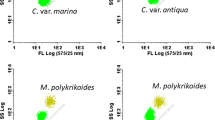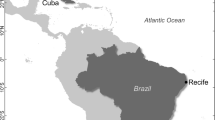Abstract
Blooms of the toxic dinoflagellate, Karenia brevis, occur annually along the Gulf coast of Florida. Other species, like Karenia selliformis, are at times found in association. Hemolytic activity, the ability to lyse red blood cells, of two K. brevis clones (SP3 non-toxic (N-tox) and SP3 super toxic (S-tox)) from the Gulf of Mexico and a single clone of K. selliformis from New Zealand was investigated throughout a growth cycle. Activity is reported as effective concentration (EC50) values, the quantitative measure of hemolysis of human erythrocytes expressed as cell numbers. Both cells and media of K. selliformis cultures consistently produced potent levels of hemolysis (maximum EC50 = 4.88 × 103 cells) from inoculation until the population declined 35 days later. For SP3 N-tox and S-tox, no hemolytic activity was detectable until day 26 of sampling. The media of both SP3 N-tox and SP3 S-tox cultures consistently contained non-detectable or low levels of hemolysis compared to K. selliformis. Maximum EC50s for the SP3 clones were 1.80 × 106 and 1.97 × 106 cells, respectively. The experimental EC50 values observed represent ecologically relevant cell densities for K. selliformis, but not for the K. brevis clones. In addition, the hemolytic activity of gymnodimine A and various PbTx derivatives was examined in this study. Our findings indicate that the hemolytic capability of these dinoflagellates, especially K. selliformis, represents an additional component of toxicity aside from their already recognized toxins and that this activity may play a larger role than was previously considered. The purpose of this study was to extend the knowledge of the biology and toxicology of species within the genus Karenia.



Similar content being viewed by others
References
Arzul G, Gentien P, Bodennec G, Toularastel F, Youenou A, Crassous MP (1995a) Comparison of toxic effects in Gymnodinium cf. nagasakiense polyunsaturated fatty acids. In: Lassus P, Arzul G, Erard E, Gentien P, Marcaillou C (eds) Harmful marine algal blooms. Lavoisier Intercept, Paris, pp 395–400
Arzul G, Turki S, Namza A, Daniel P, Merceron M (1995b) Fish kills induced by phycotoxins. Toxicon 33:1119
Baden D, Fleming LE, Bean JA (1995) In: de Wolf FA (ed) Handbook of clinical neurology: intoxications of the nervous system. Part II: natural toxins and drugs. Elsevier, Amsterdam, pp 141–175
Barton LL (2005) Structural and functional relationships in prokaryotes. Springer, New York, p 456
Biré R, Krys S, Fremy JM, Dragacci S, Stirling D, Kharrat R (2002) First evidence on occurrence of gymnodimines in clams from Tunisia. J Nat Toxins 11:269–275
Clément A, Seguel M, Arzul G, Guzmán L, Alarcón C (2001) A widespread outbreak of a haemolytic, ichthyotoxic Gymnodinium sp. in southern Chile. In: Hallegraeff GM, Blackburn SI, Bolch CJ, Lewis RJ (eds) Harmful algal blooms 2000. Intergovernmental Oceanographic Commission, UNESCO, Paris, pp 66–69
da Silva PM, Hégaret H, Lambert C, Wikfors GH, Le Goïc N, Shumway SE, Soudant P (2008) Immunological responses of the Manila clam (Ruditapes philippinarum) with varying parasite (Perkinsus olseni) burden, during a long-term exposure to the harmful alga, Karenia selliformis, and possible interactions. Toxicon 51:563–573
Eschbach E, Scharsack JP, John U, Medlin LK (2001) Improved erythrocyte lysis assay in microtitre plates for sensitive detection and efficient measurement of hemolytic compounds from ichthyotoxic algae. J Appl Toxicol 21:513–519
Guillard RL (1973) Division rates. In: Stein RJ (ed) Handbook of phycological methods: culture methods and growth measurements. Cambridge University Press, Cambridge, pp 289–311
Guillard RL, Hargraves PE (1993) Stichochrysis immobilis is a diatom, not a chrysophyte. Phycologia 32:234–263
Haywood AJ, Steidinger KA, Truby EW, Bergquist PR, Bergquist PL, Adamson J, Mackenzie L (2004) Comparative morphology and molecular phylogenetic analysis of three new species of the genus Karenia (Dinophyceae) from New Zealand. J Phycol 40:165–179
Haywood AJ, Scholin CA, Marin R III, Steidinger KA, Heil CA, Ray J (2007) Molecular detection of the brevetoxin-producing dinoflagellate Karenia brevis (Dinophyceae) and closely related species using ribosomal RNA probes and a semi-automated sandwich hybridization assay. J Phycol 43:1271–1286
Hégaret H, da Silva P, Wikfors GH, Lambert C, De Bettignies T, Shumway SE, Soudant P (2007) Hemocyte responses of Manila clams, Ruditapes philippinarum, with varying parasite, Perkinsus olseni, severity to toxic-algal exposures. Aquat Toxicol 84:469–479
Heil CA, Glibert PM, Al-Sarawi MA, Faraj M, Behbehani M, Husain M (2001) First record of a fish-killing Gymnodinium sp. bloom in Kuwait Bay, Arabian Sea: chronology and potential causes. Mar Ecol Prog Ser 214:15–23
Jenkinson I, Arzul G (2001) Mitigation by cysteine compounds of rheotoxicity, cytotoxicity and fish mortality caused by the dinoflagellates, Gymnodinium mikimotoi and G. maguelonnense. In: Hallegraeff GM, Blackburn SI, Bolch CJ, Lewis RJ (eds) Harmful algal blooms 2000. Intergovernmental Oceanographic Commission, UNESCO, Paris, pp 461–164
Kharrat R, Servent D, Girard E, Ouanounou G, Amar M, Marrouchi R, Benoit E, Molgó J (2008) The marine phycotoxin gymnodimine targets muscular and neuronal nicotinic acetylcholine receptor subtypes with high affinity. J Neurochem 107:952–963
Kim YS, Linton JR, Martin DF (1974) Hemolysis of rabbit and mullet red cells by Gymnodinium breve toxin. Toxicon 12:439–441
Kim YS, Padilla GM (1977) Hemolytically active components from P. parvum and G. breve toxins. Life Sci 21:1287–1292
Lekan DK (2008) Influence of temperature, salinity, and nutrients on growth and toxins of Karenia brevis clones. MS thesis, University of North Carolina-Wilmington, p 79
Lekan DK, Tomas CR (2009) The brevetoxin and brevenal composition of three Karenia brevis clones at different salinities and nutrient conditions. Harmful Algae. doi:10.1016/j.hal.2009.07.004
Loeblich AR (1975) A seawater medium for dinoflagellates and the nutrition of C. niei. J Phycol 11:80–86
Mackenzie L, Haywood A, Adamson J, Truman P, Till D, Satake M, Yasumoto T (1996) Gymnodimine contamination of shellfish in New Zealand. In: Yasumoto T, Oshima Y, Fukuyo Y (eds) Harmful and toxic algal blooms. Intergovernmental Oceanographic Commission, UNESCO, Paris, pp 97–100
Mackenzie L, Holland P, McNabb P, Beuzenberg V, Selwood A, Suzuki T (2002) Complex toxin profiles in phytoplankton and greenshell mussels (Perna canaliculus), revealed by LC-MS/MS analysis. Toxicon 40:1321–1330
Magaña HA, Villareal TA (2006) The effect of environmental factors on the growth rate of Karenia brevis (Davis) G. Hansen and Moestrup. Harmful Algae 5:192–198
Maier Brown AF, Dortch Q, van Dolah FM, Leighfield TA, Morrison W, Thessen AE, Steidinger K, Richardson B, Moncreiff CA, Pennock JR (2006) Effect of salinity on the distribution, growth, and toxicity of Karenia spp. Harmful Algae 5:199–212
Miles CO, Wilkins AL, Stirling DJ, Mackenzie AL (2000) New analogue of gymnodimine from a Gymnodinium sp. J Agric Food Chem 48:1373–1376
Miles CO, Wilkins AL, Stirling DJ, Mackenzie AL (2003) Gymnodimine C, an isomer of gymnodimine B, from Karenia selliformis. J Agric Food Chem 51:4838–4840
Mountfort D, Beuzenberg V, Mackenzie L, Rhodes L (2006) Enhancement of growth and gymnodimine production by the marine dinoflagellate, Karenia selliformis. Harmful Algae 5:658–664
Munday R, Towers NR, Mackenzie L, Rhodes L, Beuzenberg V, Holland PT, Miles CO (2004) Acute toxicity of gymnodimines in mice. Toxicon 44:173–178
Naar J, Kubanek J, Weidner AL, Flewelling LJ, Bourdelais AJ, Steidinger KA, Baden DG (2004) Brevetoxin depuration in shellfish via production of non-toxic metabolites: consequences for seafood safety and environmental fate of biotoxins. In: Steidinger KA, Landsberg JH, Tomas CR, Vargo GA (eds) Harmful algae 2002. Florida Fish and Wildlife Conservation Commission and Intergovernmental Oceanographic Commission UNESCO, St. Petersburg, pp 488–490
Neely T (2006) Differences in growth and toxicity of Karenia. MS thesis, Texas A & M University, College Station, Texas
Neely T, Campbell L (2006) A modified assay to determine hemolytic toxin variability among Karenia clones isolated from the Gulf of Mexico. Harmful Algae 5:592–598
Parrish CC, Bodennec G, Gentien P (1998) Haemolytic glycoglycerolipids from Gymnodinium species. Phytochemistry 47:783–787
Paster Z, Abbott BC (1969) Hemolysis of rabbit erythrocytes by Gymnodinium breve toxin. Toxicon 7:245
Pierce R, Henry M, Blum P (2008) Brevetoxin abundance and composition during ECOHAB-Florida field monitoring cruises in the Gulf of Mexico. Cont Shelf Res 28:45–58
Pierce RH, Henry MS, Blum PC, Hamel SL, Kirkpatrick B, Cheng YS, Zhou Y, Irvin CM, Naar J, Weidner A, Fleming LE, Backer LC, Baden DG (2005) Brevetoxin composition in water and marine aerosol along a Florida beach: assessing potential human exposure to marine biotoxins. Harmful Algae 4:965–972
Seki T, Satake M, Mackenzie L, Kaspar HF, Yasumoto T (1995) Gymnodimine, a new marine toxin of unprecedented structure isolated from New Zealand oysters and the dinoflagellate, Gymnodinium sp. Tet Lett 36:7093–7096
Steidinger KA (2009) Historical perspective on Karenia brevis red tide research in the Gulf of Mexico. Harmful Algae 8:549–561
Tester PA, Shea D, Kilber SR, Varnam SM, Black MD, Litaker WR (2008) Relationships among water column toxins, cell abundance and chlorophyll concentrations during Karenia brevis blooms. Cont Shelf Res 28:59–72
Tester PA, Steidinger KA (1997) Gymnodinium breve red tide blooms: initiation, transport, and consequences of surface circulation. Limnol Oceanogr 42:1039–1051
Uribe JC, Ruiz M (2001) Gymnodinium brown tide in the Magellanic fjords, southern Chile. Rev Biol Mar Oeanogr 36:155–164
Utermöhl H (1931) Neue Wege in der quantitativen Erfassung des Planktons. Verh Int Verein Limnol 5:567–596
Yasumoto T, Underdal B, Aune T, Hormazabal V, Skulberg OM, Oshima Y (1990) Screening for hemolytic and ichthyotoxic components of Chrysochromulina polylepis and Gyrodinium aureolum from Norwegian coastal waters. In: Granéli E, Sundström B, Edler L, Anderson DM (eds) Toxic marine phytoplankton. Elsevier, New York, pp 436–440
Acknowledgments
We acknowledge the Cawthron Institute of New Zealand for providing the culture of K. selliformis clone CAWD79 and Dr. E. Buskey from UTMSI for donating the K. brevis SP3 clones. This work was supported by the Centers for Disease Control and Prevention through the North Carolina Department of Health and Human Services (NC DHHS) grants no. 0150407 awarded to Dr. C. Tomas, the MARBIONC Program, and NIEHS, NIH, and DHHS grant no. P01 ES10594 awarded to Dr. D. Baden. We also wish to thank Drs. A. Bourdelais and D. Baden at UNCW-CMS for providing the PbTx standards.
Author information
Authors and Affiliations
Corresponding author
Rights and permissions
About this article
Cite this article
Tatters, A.O., Muhlstein, H.I. & Tomas, C.R. The hemolytic activity of Karenia selliformis and two clones of Karenia brevis throughout a growth cycle. J Appl Phycol 22, 435–442 (2010). https://doi.org/10.1007/s10811-009-9476-z
Received:
Revised:
Accepted:
Published:
Issue Date:
DOI: https://doi.org/10.1007/s10811-009-9476-z




